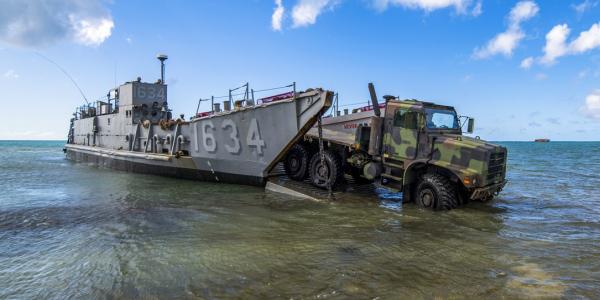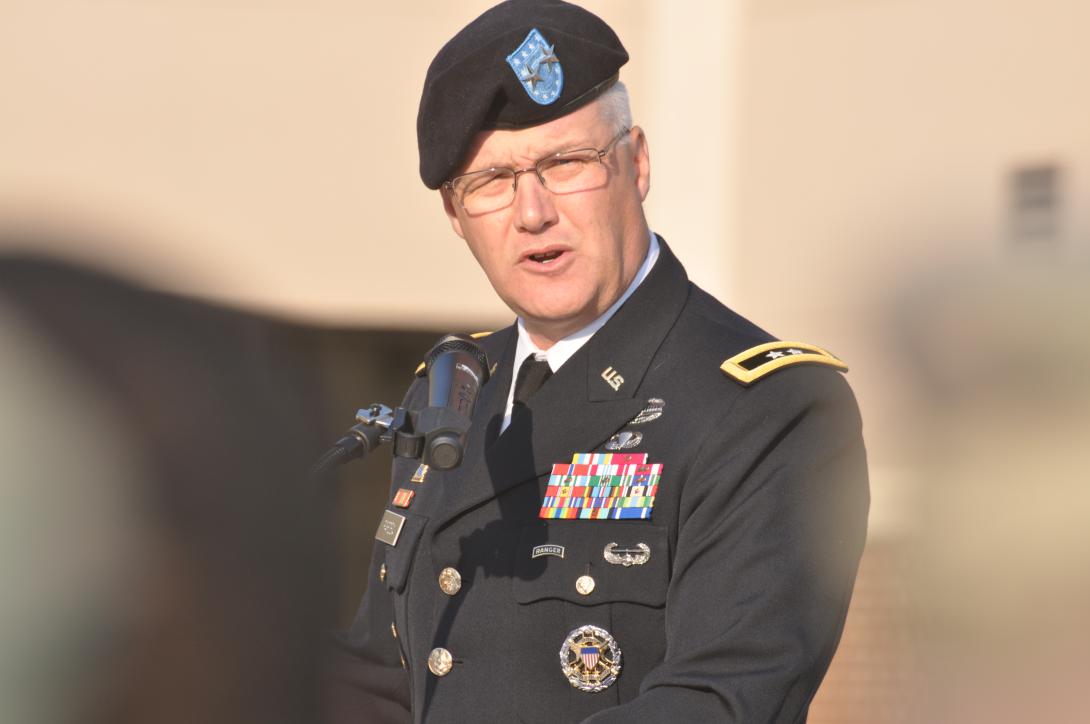Army Contracting Command Supplies the Future
With the addition of the U.S. Army’s new command, the Futures Command, the Army Contracting Command has to rise to the challenge of outfitting the future needs of the Army, as well as meeting its daily demands of the rest of the service.
The Futures Command is clearly the priority, as the Army looks to fulfill a national defense strategy that outlines threats from near-peer competitors such as Russia and China—the top adversaries threatening the United States, as well as the other nation states of North Korea and Iran. The Army stood up the Futures Command last summer as the center of its modernization efforts. Eight cross-functional teams (CFTs), which have been up and running for about a year, were designed to pull innovation into the Army as it faces asymmetrical threats in a multidomain battlefront.
“We are heavily involved with the Army Futures Command,” says Maj. Gen. Paul Pardew, USA, commanding general, Army Contracting Command. “And actually, to tell you the truth, I look at the Army Futures Command and the cross-functional teams, and for a contracting person that is really exciting stuff. We’re getting after preparing the Army out to 2028 and beyond with future vertical lift, a future ground combat vehicle, soldier lethality and on and on.”
In addition to the three CFTs the general mentions, others include long-range precision fires; network command, control, communications and intelligence (C3I); assured position, navigation and timing (A-PNT); air and missile defense capabilities; and synthetic training. Gen. Pardew confirms that the Army Contracting Command (ACC) is supporting all eight, and he has assigned them with what he calls “A-team top talent” from the ACC.
“I have a contract specialist and a contracting officer aligned to every CFT, and I’m tracking all 31 lines of effort of the Army Futures Command,” he says.
In addition, the ACC is executing all of the Futures Command’s contracts and assisting in the standup of their headquarters’ contracting cell in Austin, Texas, where the Army is establishing the Futures Command. “And thus far we’ve had a lot of early success,” the general claims.
Although there had been talk of moving parts of the ACC into the Futures Command on a more permanent basis, the ACC commander clarifies that this is not the plan at this point. ACC contracting employees are traveling back and forth to Austin and working with the CFTs across the country.
“Right now I’m taking an enterprise approach to our support to the Army Futures Command, and here’s why,” he states. “In order to run a contracting operation, it’s not just contracting people. You need lawyers and quality assurance people and property people and your legal staff and your policy staff. The overhead to run a contracting operation is pretty high,” he offers. “But what I have articulated to General Perna [the commanding general of the Army Material Command], and I think the message he has carried to the Army, is that when you have a CFT, such as future vertical lift, and you have two really highly talented contracting people working for the CFT, they’re the entry point into the larger organization. Those two contracting professionals are talking face to face with the CFT’s [Brig.] General [Walter] Rugen, but behind them are an additional 6,000 people in the Army Contracting Command that know the priority is the CFTs and the Futures Command. And if those two need help, we bring all the talent to bear to resolve issues. And so far that arrangement is working.”
It has taken a decade of investment by the Army to get the ACC from where the command began in 2008 to where it is now—a successful place, the general posits. Overall, the ACC issued $69.5 billion of contracts in fiscal year 2018. “If you look across [the Department of Defense] and the other services, the Army shares lead role on contracting,” he says. “I’m very proud of the fact that the Army is the lead in contracting for a lot of the major areas around the globe.”
Gen. Pardew, the fourth commanding general of the ACC, took over the reins in April 2018. His previous assignment as the ACC deputy commanding general for operations outside the United States has helped in his new role, as much of the command’s focus is to supply the Army’s deployments worldwide.
“I would say the demand exceeds supply,” he notes. “What I would tell you is of the eight brigades we have, even when they are at home station, they are working for Army readiness and Army modernization.”
The command has units forward in Afghanistan, including a brigade that rotates about every nine months. “They do just about everything in the field for the Army, but they are in high demand,” Gen. Pardew says. “They spend a lot of time providing private security contracts, logistics, civil augmentation contracts and intelligence contracts.” Additional contracting battalions and brigades are working with infantry brigades or infantry divisions or other units that may be forward deployed in Iraq, Syria, Jordan or Korea.
At the same time that the command has had to balance its worldwide responsibilities, it is aggressively pursuing reforms, Gen. Pardew says. Part of the reform effort includes a close look at the front end and back end of the contracting process. The command is working to improve efficiencies across the three main parts of the front-side contracting process: the contracting side, the requirement side and the contractors.
“I’ve been doing this a long time, and one of my mentors a long time ago told me that when you look at where the findings have been on issues within contracting, those issues tend to be on the front side of the contract, the requirements development, and they tend to be on the back end, the contract management,” he stresses. “There are fewer issues within the need to solicit and award the contract. The issues are in how do I get a requirement fully developed and to the solicitation phase. We lose a lot of time there.”
The reforms aim to change the culture of how the Army engages with a customer, how requirements are developed and how to get the requirements on the right contract. And on the back end, the command is looking at how the ACC manages contracts once they are signed. “We’re spending a lot of time on contract administration,” Gen. Pardew notes.
To help with the reform pursuit, the ACC is harnessing data analytics. All Army contracts go into some kind of database, the general says, and “that database, if you dive through it with data analytics, you can start measuring where you are.” They are applying data analytics to any active contracts. On average, a contract roughly may have a five-year life, which if “you look across all five years of activity, that’s about just short of $500 billion dollars of contracts,” he notes. A close look at trends may help the command find where it can apply strategic contracting.
The measurements also are meant to gauge how well the ACC performs property accountability. “We need to make sure that the things are maintained, and then how well we manage oversight of the contracts, and if we are actually performing the quality assurance surveillance that we need to do,” Gen. Pardew shares. “If you don’t do oversight, you’re not going to get what you pay for it. If I spend $100 million on a service contract, I want to make sure I’m getting $100 million out of it because if a million dollars falls off the table, that’s a million dollars I could have used on modernization and readiness that we lost. So that’s been the driving message.”
The data analytics the ACC is pursuing dovetail nicely into the Army’s new category management program started last fall. The category management effort allows the Army to look at its budget spent across the portfolio, he says.
Gen. Pardew also confirms that the Army is relying heavily on other transactional authority (OTA), a contracting tool meant to drive innovation through rapid prototyping. Across the Department of Defense, the Army accounted for about 72 percent of the OTA spend in 2018. And although OTAs only represent 4 percent of the Army’s overall contracting expenditures, “we effectively doubled the Army OTA spend between FY 2017 to FY 2018,” he notes. “So we are out of the chute and running on using OTAs,” he shares. “And I think we’ve been very successful in their use, especially over the last 12 months.” The CFTs especially are using OTAs. For example, the Soldier Lethality CFT has several OTAs running across multiple efforts, the general adds.
The ACC commander acknowledges that the Army has to be careful in how it uses OTAs. “Congress gave us the authority to use OTA for a very specific reason, for modernization and readiness,” he notes. “So we’ve been very, very discreet in where we will use them. And where they’re not appropriate, we won’t use them.”
He adds that when using OTAs, “you have to know where you’re going to go long-term.” A user has to be clear if the contracting is for one-time prototyping or if the intent is to ultimately go to production with a Federal Acquisition Regulation (FAR)-based contract. “You have to do some long-term thought on where you’re going to go with that,” Gen. Pardew advises.
The commander does not see the demands on the ACC letting up anytime soon, but as a lifelong dedicated Army leader, he is okay with that issue. “Look, this is really, really exciting stuff,” he stresses. “It’s going to be challenging. It’s going to be a lot of hard work. But at the end of the day, an ACC employee is going to sign a contract that will effectively be providing the Army with a new helicopter for the next 40, 50 years. I mean, that’s pretty neat. And I think if we can really get after it, over the next two years we can effectively leapfrog the Army from a modernization perspective.”






Comments